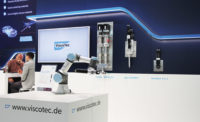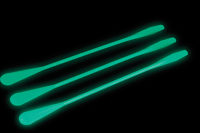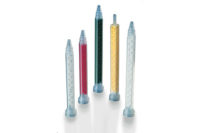
A burst seal pack divides two different materials by an interior barrier in a plastic pouch. (Photo courtesy of Andpak Inc.)

An injection kit contains the catalyst inside a valve mixing rod, while the base is inside the cartridge. All of the material inside the kit is mixed within the package. (Photo courtesy of Semco Packaging & Application Systems.)

In a barrier kit, the catalyst and base are separated by an aluminum foil barrier formed over the mixing head. (Photo courtesy of Semco Packaging & Application Systems.)
Kit Basics
Multiple packaging options exist for applying adhesives to substrates. The manufacturer or distributor may supply kits in bulk or “proportioned kits” that are supplied in containers designed to facilitate the combining and mixing of their contents. In these instances, part A and part B of the adhesive are packaged separately and supplied as a kit. One of the containers typically includes enough head space to accommodate the other component, with a little extra room for mixing. Accordingly, the materials (particularly those with a simple mix ratio, such as 1:1 by volume) could be successfully proportioned and mixed by hand. In theory, the metering is done at the factory, and the only thing the operator needs to do is follow the mixing instructions.However, problems exist when hand packaging or using bulk containers. Hand mixing can introduce air, and judging material volumes-as opposed to weight-could cause difficulties that might result in operator errors. Operators could also intentionally adjust the mix ratio to compensate for a production condition and add “a little extra” catalyst or hardener to speed up the cure, thus inadvertently affecting the functionality of the adhesive. In addition, the repeated opening and closing of the containers could contaminate the material or compromise its shelf life.
Another issue that is specific to proportional kits occurs when the operator leaves material stuck to the inside of the “emptied” container after pouring the contents. The result is wasted material and the potential for an off-ratio mixture, because an inadequate amount of catalyst is left for the remaining quantity of sealant. Off-ratio or improper mixing adversely affects the adhesive’s performance.
To eliminate the potential of mix ratio or operator errors, a variety of practical solutions are available to users of multi-component materials when the application requires a limited amount of material to be mixed and applied. Specialty packaging options are supplied with the intent of dynamic or static mixing, as well as other user-friendly kit options.

Side-by-side cartridges are a mix-on-demand system in which the individual components are packaged into separate cartridges. (Photo courtesy of Sulzer Mixpac USA Inc.)
Dynamic Mixing
In a dynamic mixing scenario, the adhesive components meet in a mixing chamber and are homogeneously combined by a mixing element. Dynamic mixing provides the user with a high shear force, which is required for a range of materials-from thin liquids to heavy pastes-with high mix ratios and varying viscosities.Dynamic mixing can be accomplished with injection- and barrier-style kits, both of which can accommodate any ratio of material. Commonly made of polyethylene, these kits are supplied in various sizes (e.g., 1, 2.5, 6, 8 and 20 oz, and 1/10 gal). Labor-intensive tasks like the measuring and handling of materials are completely eliminated, thereby preventing the possibility of material contamination. When properly performed, this method also dramatically reduces operator exposure to chemicals and fumes. In addition, the package ensures accurate proportioning of materials, since the pre-measured components are stored in separate compartments within the cartridge.
Barrier and injection kits are used for specific material ratios. The barrier kit is used for compounds with a volumetric ratio of more than 10 parts per 100, while the injection kit is used for ratios of less than 10 parts per 100. In a barrier kit, the catalyst and base are separated by an aluminum foil barrier formed over the mixing head. An injection kit contains the catalyst inside a valve mixing rod, while the base is inside the cartridge. All of the material inside the kit is mixed within the package. The semi-translucent package allows for visual inspection that a thorough mix has been achieved.
After the components are thoroughly mixed, a nozzle is attached and the material is either manually or pneumatically dispensed with a handheld gun. Many nozzle options are available for specific applications. For automated dispensing applications, adapter heads are attached to dispense the material using needles. There are no intermittent uses of this package, and all of the material must be dispensed within the materials’ working or pot life.
Mixing energy for these types of kits is generated through either manual or mechanical means. To optimize the mixing effect and obtain a consistent mix between kits, the rotational speed can be controlled and varied electronically.
These types of dynamic pre-weighted packaged kits offer many advantages:
- Correct ratio
- Guaranteed mix with a wide range of materials
- Minimized exposure to chemicals
- Capable of handling many different materials (such as polysulfides, epoxies, polyurethanes, etc).
- Internal package mixing system
- Can be sized to the job (e.g., different cartridge sizes and filling levels)
- Convenient application
- No special storage required
- Capable of handling unique ratios
- Good packaged product shelf life
- Clean, healthy and safe work environment
- No risk of material contamination during the mixing process

The new generation of syringes is designed with thick walls for high-pressure dispensing. (Photo courtesy of Semco® Packaging & Application Systems.)
Static Mixing
The next type of package involves static mixing, which incorporates a method for delivering two streams of materials into a static mixer. No shear action is involved, even as the materials are continuously being metered and passed through numerous splits throughout the tube. Because there is a chance that the materials will not be sufficiently mixed, the metering of the individual components to the mixer is crucial. As the streams move through the mixer, the non-moving elements continuously blend the materials. If one component enters the mixer before the other, it will pass through the mixer on its own and result in an improper ratio of the material, which will affect the product quality or characteristics. Complete mixing is therefore dependent on many variables, including the fluid properties, tube inner diameter, the number of elements, and the elements’ design.Depending on the volume and mix ratio of the material, static mixing systems incorporate the use of side-by-side or coaxial cartridges, or dual syringes. Side-by-side cartridges are a mix-on-demand system in which the individual components are packaged into separate cartridges. Commonly used cartridge sizes include 50, 200 and 400 ml, with mix ratios of 1:1, 2:1, 4:1 and 10:1 (by volume). The materials in the cartridge are forced through the dispensing end into the static mixing nozzle. As the metered materials pass through the tube, each element splits the stream into multiple streams to achieve a mixing effect throughout the entire length of the nozzle.
Again, mixing nozzle designs comprise a series of mixing elements inside a tube. An extrusion gun extrudes the material through a static mixer, which also serves as the dispense nozzle. The static mixer is disposable, thus enabling the intermittent use of this type of package.
A coaxial (or universal) cartridge is a static mix system that features properties similar to those of the side-by-side cartridge, but uses two individual cylinders (one within the other) to separate the reactive material until it’s used. The coaxial cartridge is typically available in 75-380 ml sizes, with mix ratios of 1:1, 2:1, 4:1 and 10:1 (by volume). The universal cartridge was designed to fit a standard caulking style or 1/10-gal cartridge that is available in 1:1, 2:1 or 10:1 mix ratios (by volume). An extrusion gun is used to simultaneously push the pistons and deliver properly rationed material into a static mixer that also acts as the dispense nozzle. This system enables intermittent use by virtue of its disposable/replaceable static mixer.
Another static mix system involves side-by-side syringes, which are designed for low- to medium-viscosity adhesives with limited ratios (generally 1:2 and 2:1 by volume). This package features a dual plunger that empties both syringe barrels simultaneously. The only task remaining is to ensure proper mixing of the dispensed material using a stick or spatula. Alternatively, side-by-side syringes can be equipped with an attachable static mix nozzle to mix the material as it is dispensed.
Additional Options
Other packaging options are available based on consumer needs and demands. For example, the syringe was originally intended for medical applications. Though the medical syringe was not designed for pneumatic applications with the precise dispensing of small shots that require repeatability and high accuracy, technological developments have modified the syringe for industrial applications.The new generation of syringes is designed with thick walls for high-pressure dispensing, as well as a radius on the luer-lock end to permit air-free filling. In addition, the luer-lock connection allows material to be dispensed using needles and a luer-slip outlet for the direct application of industrial materials. Made of polypropylene, these small syringes are supplied in various sizes, including 1, 3, 5, 6, 10, 20, 30, 35, 55 and 60 cc. Syringes are complemented by a range of pistons or stoppers to facilitate various applications, materials and viscosities. These small syringes are ideal for one-part or pre-mixed and frozen material application, and can be dispensed either manually or pneumatically.
Another example, the divider bag, contains parts A and B in a plastic sleeve with a spline separation. To mix the materials, the operator removes the spline and kneads the materials together within the sealed plastic pouch. Similarly, a burst seal pack divides two different materials with an interior barrier in a plastic pouch. The interior barrier bursts open after the operator applies pressure to one side of the package. After kneading the material thoroughly, the corner of the pouch is cut open to squeeze out the material. (This method may not provide adequate mixing with some materials because of variations in viscosity, material ratio and operator handling.)
Packaging Choices
It is important to consider many details when looking at multiple packaging options. However, end users should remember that no single kit solves all problems; each kit offers its own advantages and disadvantages. The operator must decide on the type of kit that works best based on the material properties and application requirements. A proper analysis should therefore be undertaken before choosing the appropriate adhesive package.For additional information, contact Semco® Packaging & Application Systems, a division of PPG Industries, at 12780 San Fernando Rd., Sylmar CA 91342; phone (800) 237-6649; or visit www.semcopackaging.com.


